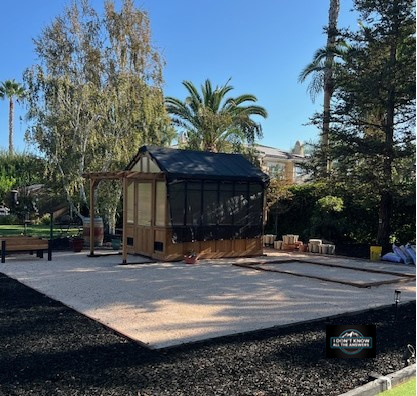My Greenhouse Journey
I am a greenhouse enthusiast, and I’m excited to share the second phase of my greenhouse journey with you. After several months the second phase has begun. Meanwhile, it’s been a rollercoaster of a learning curve filled with challenges. With the major hurdle being the control of greenhouse temperatures. Despite my best efforts, I’m still struggling to keep the temperature below 100° during the day.
As I follow several gardening channels, I’ve noticed a lack of discussion on greenhouse problems. This leads me to believe that I’m not the only one facing this challenge. Can you relate to this?
Temperature Challenges in my Greenhouse:
Before I get into possible solutions, I want to address the temperature challenges I’ve faced:
- Overheating due to excessive sunlight, especially during this summer. The external temperatures have been triple-digit.
- External temperature fluctuations: Temperatures rise during the day and drop at night.
- Inadequate ventilation traps heat inside the greenhouse. Even with the built-in ventilation fan, the temperatures never drop to a manageable level.
- Energy inefficiency leads to high operational costs.
- Inconsistent temperatures will cause plant stress. Although I would like to use the greenhouse year-round, I now realize that if I can’t control the temperature, I can only use it during the spring, fall, and winter.
Why Temperature Control Matters
Understanding the crucial role of temperature in plant health is empowering. Excessive heat can lead to wilting, poor growth, and even death. Similarly, inconsistent temperatures can stress plants, making them more susceptible to diseases.
Solutions to Control Greenhouse Temperatures
While I’ve already mentioned some of these solutions, it’s important to note that they might not work for everyone or every situation. However, I believe they’re a good starting point for our discussion.
- Improve Ventilation
Proper airflow is essential. Consider installing additional vents or using exhaust fans to pull hot air out. Roof vents are particularly effective as hot air rises. I have yet to add an extra fan, and my greenhouse does not have roof ventilation.
- Utilize Shade Cloths
Shade cloths come in various shade levels (e.g., 30%, 50%, 70%). While I’ve installed two shade cloths (both are 70%), I might need to experiment with further layering. Layering shade cloths can provide better results.

- Implement an Evaporative Cooling System (Swamp Cooler)
I am considering adding a swamp cooler. Swamp coolers (Evaporative coolers) can be a game-changer. These systems use water to absorb heat, cooling the air as it passes through. They’re an energy-efficient way to lower temperatures.
- Insulate Your Greenhouse
Another recommendation I found is adding insulation to a greenhouse. Insulation isn’t just for winter. Reflective insulation can help keep out excessive summer heat. Consider adding reflective panels or whitewashing the exterior to reflect sunlight.
- Automate Temperature Control
Automation can save a lot of headaches. Set up thermostats to automatically open vents or turn on fans when the temperature reaches a certain level. This ensures that temperature control is consistent and less labor-intensive.
Note: The greenhouse I purchased has this feature, but I can’t get the internal temperature below the level I want to set the activation at.
- Use Thermal Mass
Thermal mass involves using materials like water barrels or concrete to absorb heat during the day and release it at night. This can help stabilize temperatures inside the greenhouse.
- Plant Strategically
Place heat-tolerant plants on the edges where temperatures are higher and more sensitive plants in the center. This can help balance the microclimates within your greenhouse.
My Final Thoughts
If you’re thinking about buying a greenhouse, I do not want to discourage you! However, I want to be realistic and share the challenges I’m facing. Remember that every greenhouse is unique, and what works for one might not work for another. It’s all about experimenting and finding the right balance for your specific setup.
I am trying not to be disheartened and continue working to get it right. It’s a learning process, and every misstep brings me closer to mastering my greenhouse environment.
If you’ve faced similar challenges or found solutions that worked for you, your experiences and solutions are invaluable. Let’s learn and grow together as a community!
References:
Traditional, low-energy air conditioning solutions for sustainable homes. https://www.portaire.com/journal/traditional-low-energy-air-conditioning-solutions-for-sustainable-homes
Thank you for reading this blog post. If you have any questions or comments, please leave them in the Comments section below.
Copyright © 2019. I Don’t Know All The Answers, Nikki Mastro.
All of my photographs and documents are Copyrighted.
No part of this website, including text, photographs, and documents, may be reproduced, stored in a retrieval system, or transmitted in any form or by any means without written permission from the copyright holder. All unauthorized use is strictly prohibited. If you choose to copy or share any information from my site, you must provide a link to the source. I appreciate your cooperation.
For further information concerning “I Don’t Know All The Answers.”
– Website and Blog: https://www.idontknowalltheanswers.com
– Facebook: https://www.facebook.com/Nikki.L.Mastro/
– Instagram: https://www.instagram.com/i_dont_know_all_the_answers/
– Linkedin: https://www.linkedin.com/in/nikki-mastro-05455a3a/
– Youtube Channel: https://www.youtube.com/@idontknowalltheanswers1954

